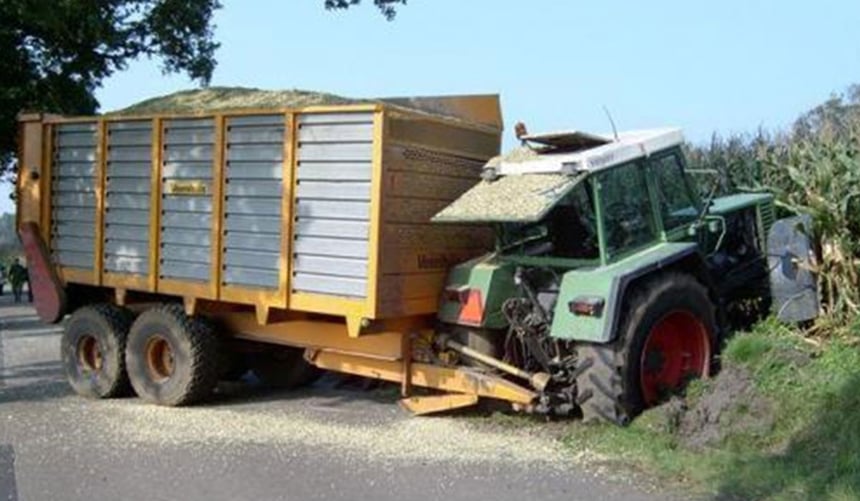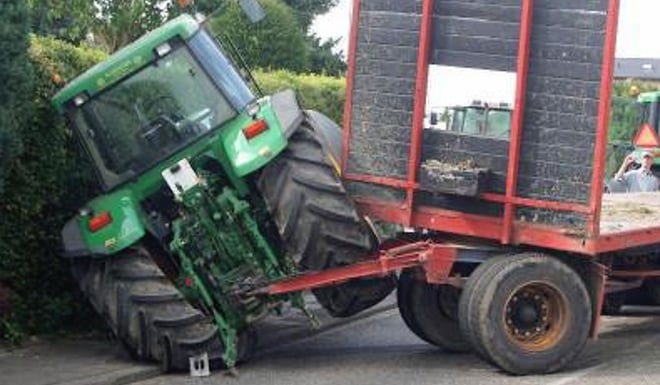Are your certain that you always know your tractor’s braking capacity? When you drive with a full trailer, have you asked yourself what stopping distance is necessary in the event of emergency braking?
Your tractor tyres play a decisive role in your capacity to brake rapidly and certain tyres can help you win a few meters whereas others require almost double the distance for your trailer to come to a complete stop.
Your tractor’s primary purpose is not transport but working the land at reduced speed. Generally, a tractor with 4 drive wheels only has brakes on the rear axle, an automatic mechanism triggers the front axle when the brake is applied.
If you wish to increase speed on the road, it is necessary to equip your tractor with a more powerful and more efficient tyre braking system. As the speed limit for tractors is 40 km/h, the difficulty is not reaching this speed but stopping the combination vehicle safely.
The brake force acts directly between the tractor tyre and the ground
 The quality of your tyres is essential because during braking, the load increases on the front axle and is reduced on the rear axle which therefore participates less in the transmission of the braking force. The full mass of the tractor is pushed onto the front tyre.
The quality of your tyres is essential because during braking, the load increases on the front axle and is reduced on the rear axle which therefore participates less in the transmission of the braking force. The full mass of the tractor is pushed onto the front tyre.
A discount agricultural tyre or cheap tractor tyre is not suitable and will not react correctly when the emergency brake is applied. You may lose control of the steering especially if you are pulling an attachment or loaded trailer, the load transfer to the tractor will be too great and the tractor may even end up rolling over.
When braking on soft soil, the ground gives way under the pressure of the tyre which sinks until it meets with resistance, in this case the compaction of the soil ends up balancing out the pressure applied by the tyre. The deformation of the tyre depends on two things: its pressure and the weight it bears.
The higher the pressure in the tyre the less the tyre is crushed. This is why it is so important to adapt pressure between road (high pressure for speed and good braking) and field (low pressure to avoid compaction).
The low-pressure VF tyre reduces braking distance
The braking distance necessary to bring a trailer to a halt is in proportion to the total mass of the combination vehicle and the slowing down speed desired.
Better than dual wheels, the use of wide VF technology tyres (reinforced sidewalls for improved flexion) and the right tyre pressure settings decrease the extent to which the tyre sinks into soft ground and on the road, the tyre crushes into the ground in a controlled way during emergency braking, increasing the contact surface between the ground and the tyre and therefore spreading the braking force better.
The braking distance is reduced by several meters in the event of emergency braking with a heavy trailer which could be crucial for your safety.
The Bridgestone-agriculture.eu blog is written and administered by agricultural tyre experts who are available to provide you with the advice you need on the subject of your tyres. They can help you to maximise your productivity with information on all aspects related to tyres: Technical data for agricultural tyres - Agricultural tyre performance - Air pressure advice - Solutions to avoid soil compaction - Sprayer tyre pressure – Why and how to ballast your tractor tyres - The 6 principal mechanical causes of abnormal wear to your tractor tyres – etc….
Learn more
If you’d like to read more about the causes and consequences of overturning, download the white paper below for free:
Most people who read this article have also read some of the following articles:
This information is intended only to make you aware of the technical and functional aspects of agricultural tires and their use. It does not allow you to make a judgment or a definitive conclusion on a given problem. Only your agricultural tire expert is able to make a technical assessment and take a final decision, case by case.
Leave a
commentary
Your email address will not be published.
Required fields are indicated with *








